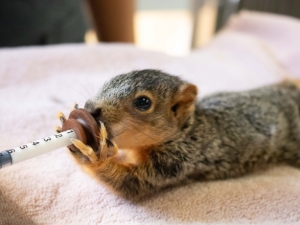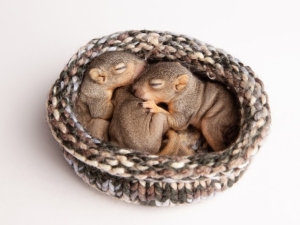Pasadena Humane has a soft-spot for helping squirrels, as well as cats, dogs and other critters

Orphaned baby squirrels are cared for at Pasadena Humane’s Sandra J. Goodspeed Wildlife Center until they’re ready to be released back into the wild.
As you may have noticed, in recent years we have had a proliferation of national days of appreciation and recognition. National Ice Cream Day, celebrated the third Sunday in July, happens to be one of my favorites.
Of course, there are many animal- and pet-related national days, and I love those, too. Did you know January 21, 2022 is National Squirrel Appreciation Day? I would like to think it is one of Sueshi’s favorite days. If you are new to my column, Sueshi is my little white fluffy dog.

Orphaned baby squirrels are cared for at Pasadena Humanes Sandra J. Goodspeed Wildlife Center until they’re ready to be released back into the wild.
Sueshi, like so many of her canine brethren and sistren, loves nothing more than a squirrel sighting. She could spend hours gazing up at a tree wondering how she might get to where that squirrel is.
It turns out Sueshi and those squirrels have something in common. Animals are so intelligent.
If you google National Squirrel Appreciation Day, you will see, “squirrels bury nuts. But did you know that they often will only pretend to bury those nuts, in a sort of fake move, because they know that they’re being watched? Sometimes, squirrels will pretend to bury a nut, walk away, then come back to it as many as five times, removing it and putting it somewhere else until they’re certain that they weren’t being watched.”
My Sueshi does the same thing, albeit not with nuts, but with treats. If you walk into a room while Sueshi is trying to “squirrel away” a treat in a blankie on the couch, for example, she will look at you like, who me? then immediately find another spot for that treat, maybe behind a curtain.
You could be forgiven if you don’t make an immediate connection between animal shelters and squirrels. Pasadena Humane is one of a few animal shelters that holds state and federal permits to rehabilitate wildlife.
We commonly care for mammals — like squirrels, skunks and opossums – at our Sandra J. Goodspeed Wildlife Center. Occasionally, we help the odd bobcat cub, pelican or alligator lizard, and in spring we nurture many orphaned birds, like woodpecker and hummingbird chicks.

Orphaned baby squirrels are cared for at Pasadena Humane’s Sandra J. Goodspeed Wildlife Center until they’re ready to be released back into the wild.
While it might seem counterintuitive, in most cases, the best thing to do if you find a baby wild animal is to leave it alone. Mom could be away gathering food or you may have encountered a juvenile animal that is big enough to be on its own.
Of course, there are times when human intervention is appropriate. If the animal is visibly sick or injured, you’ll want to seek help right away. If babies are truly orphaned, they will benefit from your help, too.
If you think you may have found an orphaned baby squirrel, here are the first steps to take:
- Try to locate the original nest. If you can find the nest, place the animal back in the nest. It is a myth that parents will reject their young if they have been touched by humans.
- If you are unable to locate the nest, make a nest using a shallow box with holes in the bottom for drainage, and add towels and a warm rice-filled sock. Place the nest as high up in the tree as you can reach.
- Once the baby is in a nest, wait at least four hours or overnight for the mom to return. If the baby is not crying, you can play squirrel baby chirps from your phone to help mom find her babies. Make sure you are out of sight, so you won’t scare mama away.
- If the mom returns, no further steps are needed. If the mom does not return, or if the baby’s condition declines, you’ll want to text or call our wildlife helpline at 626-344-1129.
At Pasadena Humane, we love all animals, both companion and wild. Our vision is for all companion animals to reside in loving homes, and for humans to peacefully co-exist with our wild neighbors.
The Pasadena Humane website is a great wildlife resource, with education on how to peacefully co-exist with coyotes, what to do when you find baby birds and mammals, and so much more!
A pro tip, if you see a squirrel hiding a nut, don’t expect to find that nut later.
Dia DuVernet is president and CEO of Pasadena Humane.



